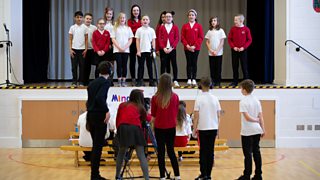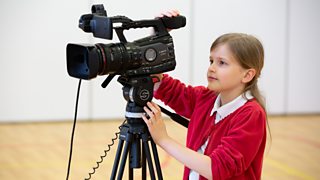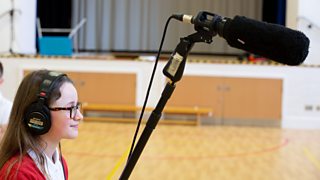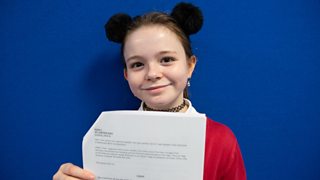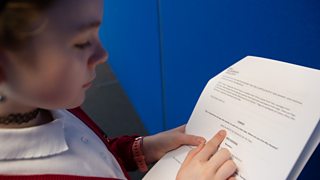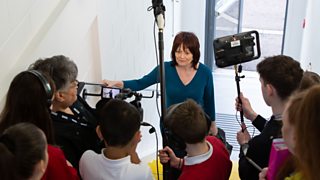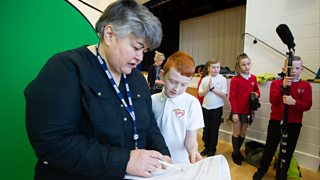Stand by, Speed, Action
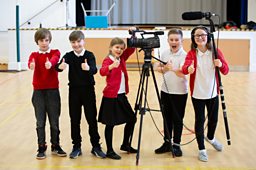
How to use this resource
These activities are aimed for teachers to support mental health, but the activities could be adapted to work alongside literacy, numeracy or social studies. They are designed as a framework to support children’s understanding of how a film is created.
The activities are adaptable in small blocks of learning and can be used as a part or extended to suit the needs of your pupils developing film production: research and ideas, production, filming and post production.
Filmmaking can seem a little daunting with the class but remember you don't have to make a whole film every time you use film in the classroom!
“Along with literacy and numeracy, health and wellbeing is one of the three core areas that are the responsibility of all staff in the school. All adults who work in Scotland's schools have a responsibility to support and develop the mental, emotional, social and physical wellbeing of pupils, as part of what is referred to as 'Responsibility of All'.”
Mental Health Strategy 2017-2027
The Scottish Government's approach to mental health from 2017 to 2027 – a 10 year vision.
The benefits of using filmmaking with pupils are huge, particularly for developing creativity and boosting confidence, as well as developing dialogic strategies and techniques. Filmmaking requires careful planning, mutually respectful relationships and skilful facilitation. The different roles on a film set are great at targeting specific skills such as communication and teamwork - so leadership and decision making skills can be developed through directing, while operating the camera is great for developing listening skills.
Experiences and Outcomes have been bundled according to their natural links through this framework. Teachers may find that they are teaching the same Es and Os in different bundles which can help to ensure depth of learning.
- I regularly select subject, purpose, format and resources to create texts of my choice.
LIT 1-01a / LIT 2-01a
- When I engage with others, I can respond in ways appropriate to my role, show that I value others’ contributions and use these to build on thinking.
LIT 2-02a
- I can select ideas and relevant information, organise these in an appropriate way for my purpose and use suitable vocabulary for my audience.
LIT 2-06a
- I am developing confidence when engaging with others within and beyond my place of learning. I can communicate in a clear, expressive way and I am learning to select and organise resources independently.
LIT 2-10a / LIT 3-10a
- I enjoy creating texts of my choice and I regularly select subject, purpose, format and resources to suit the needs of my audience.
LIT 1-20a / LIT 2-20a
- I consider the impact that layout and presentation will have and can combine lettering, graphics and other features to engage my reader.
LIT 2-24a
- I have experienced the energy and excitement of presenting/performing for audiences and being part of an audience for other people’s presentations/performances.
EXA 0-01a / EXA 1-01a / EXA 2-01a
- I have the opportunity to choose and explore an extended range of media and technologies to create images and objects, comparing and combining them for specific tasks.
EXA 2-02a
- I have created and presented scripted or improvised drama, beginning to take account of audience and atmosphere.
EXA 2-14a
The process of making a film happens in 3 parts: Pre-production, Production & Post- production
Pre-production - Planning and organisation

Key Questions:
What will be the theme of the film?
How many people will be working on the film?
How many acting roles with there be?
How long will the script be?
What equipment do we have?
Where can we film?
Will this be a whole class film, or will there be several small films?
PRE-PRODUCTION - RESEARCH
For this particular project, pre-production was:-
Activity 1
When we are physically healthy we feel good about ourselves, just as when we are mentally healthy. Good mental health allows us to feel and manage the full range of our emotions, cope with life's ups and downs, feel in control of our lives and to ask for help from others when we need support.
Discuss how to look after your physical health. Now, encourage the pupils to think about looking after their mental health; talk about happiness, excitement and calmness through to less comfortable feelings such as anger, fear or sadness.
Link to web pages

Planning and writing – The starting point
The ideas and story behind our film :
- An alien
- An incident causing the spaceship to land on Earth
- The alien interacting with children and discovering kindness and calmness
- The alien will leave again with the emotion discovery, and at least one other character will change emotionally too
Activity 2: The Alien
Discuss and describe: Where did it come from? How did it get here? Why had it come to Earth?

List three things we know about the alien? Draw a picture of the alien (avoid green, could be using a green screen as part of the film process)
Story Structure: Encourage pupils to think about the story of Jack and the Beanstalk and identify the key points from the story
- An everyday setting
- An incident that happened which changed things
- The incident got worse
- A crisis
- A resolution which changes things for one or more of the characters.
This is the basis for the children’s storyline. Their story should follow the same format and feature the alien.
Activity 3: Developing the script
Important points for scriptwriting:
- Dialogue is spoken
- Every word has a purpose, keep it short and direct, to drive the plot forward or reveal something about the character
- If you can show it during the action you don’t need to explain through dialogue.
The narrator has a different role from the rest of the dialogue. The narrator has a friendlier manner, explains and describes what’s happening and talks in prose.
Characters: the main speakers
When thinking about these characters they all must be different in some way and have a purpose in the story
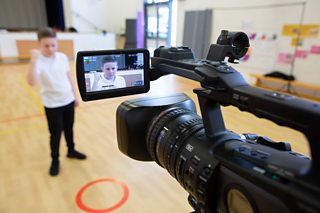
• main character- (our alien )
• a friend
• a character who would go from good to bad or bad to good
• an enemy
• a character who gives advice.
Encourage discussion and support the children to come up with names for each character. Choose names which could be male or female and no class names.
Promote the identifiable features of the characters and why they appear the way they do:
The Friend – kind, loyal, understanding, respectful, trustworthy
Think about the different scenarios from the earlier story structure and encourage the children to think about these significant moments and explore how each of the characters will respond to each other in given situations.
In this activity, pupils create an outline for the characters in the story, paying close attention to the feelings and actions of both main and minor characters. Pupils can also provide detailed information regarding the character’s actions, how they influence other characters, and how the main character changed over time.
Storyboard
Pupils can independently or in groups create a story board (use links below ). This can be can be created through narration and drawing still pictures.
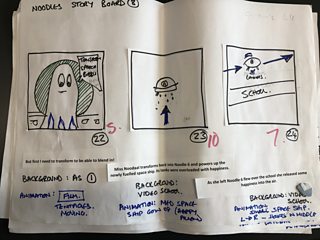
This is a particularly useful approach for visual learners to organise their ideas, recall relevant information and present information in a logical sequence.
Locations, roles and top tips for acting–
Use these short films to give you some hints and tips.
Locations, roles and top tips for acting
Use these short films to give you some hints and tips.
Location
-
![]()
Where and when to film.
The director decides what spaces will be used.
Roles
-
![]()
Camera Operator
Check out these handy tips on how to be a camera operator.
-
![]()
Sound Recordist
Here are some top tips to recording sound.
-
![]()
Director
Top director Jaqui McAlpine share her top tips for directing.
-
![]()
Producer
Some top tips about how to be a producer.
-
![]()
Production Coordinator
Some top tips about how to be a production coordinator.
Acting
-
![]()
Acting
Some top tips into acting with Maureen Carr.
Organisation and management activities:
1. Drama workshop to explore conversational dialogue and determine who could play the main roles.

Rotate the roles during the sessions to give everyone the opportunity to try acting, being the director or filming. Every role on a film shoot requires different skills, so rotating means that everyone receives a well-rounded experience and the chance to discover what they're good at.
2. GROUP 1 -Actors and Writers - use the storyline to add detail, expand ideas and add dialogue. Actors will learn their lines and begin rehearsing.
3. GROUP 2 – Core crew - learn to work the film equipment. Every team should have director/ sound/ camera as core crew. (see appendix for film tutorials)
4. Director - see appendix for film tutorial
5. Schedule - Make a filming schedule. This means everyone knows what is happening and when.
6. Props- Look at the script and filming schedule and work out the props you need and what props have to be made. Someone should be in charge of organising props.
7. Remember to charge the equipment and check batteries in preparation for your filming day.
PART 2 - A few suggestions to incorporate filmmaking into your classroom
PRODUCTION – Plan, plan, plan and smile
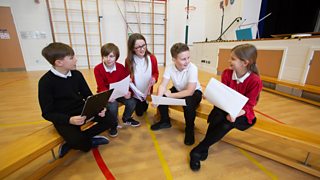
- PRODUCTION MEETING – Start with a meeting to explain and discuss the plan for the day.
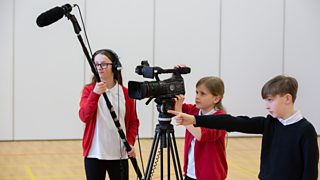
• CREWS – To allow as many pupils as possible the chance to try different roles try different crews for each scene. These crews must be planned and organised. Crews should learn to work as one team with the director in the lead role.
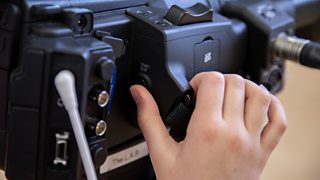
- EQUIPMENT – Check the equipment and how it works before you start filming. Are the batteries charged? Have you enough film memory?
- CONTINUITY – If filming is over a couple of days or shot out of sequence, someone should be in charge of making sure the characters look the same as they did in the scene before and that props are in the correct hands, etc. A quick digital picture taken on phone or tablet at the end of each scene will act as a reminder.
- REHEARSAL – This is useful for the crew and the actors. The director will tell the actors where to stand to deliver lines and where to move to. It lets the director see what things will look like on camera.
- THE SHOT LIST
- The director will decide the scenes necessary to make the story work and organise them in order.
![]()
- All the shots to be taken in the same locations should happen at the same time.
- This will be the order you shoot your scenes in.
- Stick to the plan.
- Remember the director is in charge…listen to them.
- At the end of the shot list will be ‘nice to have’ extra material, this can be included if there is time.
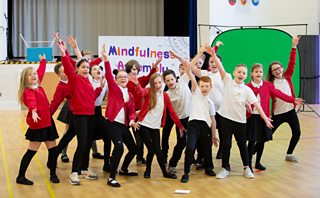
- TIME – Filming always takes longer than you think, always leave enough time and then a bit more. Remember you will be rehearsing the scene before you start. Add time for breaks and try to keep to the planned schedule for each scene.
- ABSENCE – Can another person step into the role or will you reschedule filming? Have a plan if someone’s off sick.
- WEATHER – What will happen if it rains and you are filming outside? Have you an alternative location? Remember people are waterproof; equipment isn’t…do you need umbrellas?
- THE FOOTAGE – Check you have recorded the scene and make sure you are happy with the footage before you move to the next scene.
- NOTES – It is useful to have someone to keep a note of the best take …usually it will be the last one (but not always).
- BACK UP FOOTAGE – When your filming day is over, leave time to take the material from the tablet/ phone/ camera and back it up …in two places if you can. You might have to clear your camera and have space for shooting the next day.
- HAVE FUN – Filming should be an enjoyable experience. Try not to stress out. If something isn’t perfect, that’s what retakes are for!
POST PRODUCTION
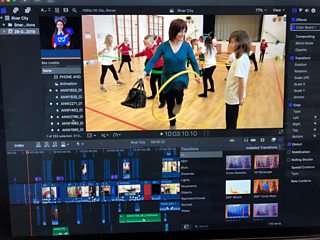
- EDITING –Upload your material into your editing software. The important thing is to get everything in place and tell the story, then you can get creative. The story must make sense. Editing takes longer than you think…allow a bit of time for tweaking.
- MUSIC- Do you need music? Unless you have permission or are going to pay for music …use copyright free music or better still, create your own music for the film using instruments and voices.
- SOUND EFFECTS – You might want to add some sound effects to help the story. You can make these yourself and add them in. Sometimes the actual sound of an object might not sound right…you might have to get creative!
- GRAPHICS – In our film we had a whole section, which was stop frame animation. In post-production we put the voices under this. You could do this with drawings.
- SIGN OFF – The person who has the final say to whether it is finished or not, will ‘sign off’ the film.
- CREDITS – Everyone likes to see their name in lights. Remember the correct spelling of names and include everyone who helped? If anyone is under 16, use first names only.
THE PREMIER – Roll out the red carpet!
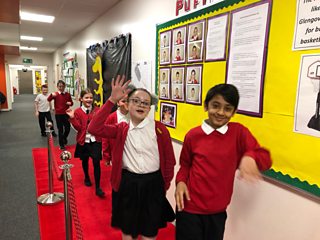
- TEAM – Is there a team of people looking after this event? Have they all got roles?
- WHO – Who will be coming along? Will you have to make invitations? Will you send invitations/ letters? Do you need film posters to advertise?
- WHERE – Do you have a hall or classroom to hold the premier? How will you set out the chairs? Will it be dark enough? How can it be decorated?
- EQUIPMENT – How will you show the film? Have you thought about sound and speakers?
- DRESS CODE – Have you a theme, maybe related to the film? Would you encourage your guests to dress up?
- THE RUNNING ORDER – Have you a host for the event? Will anything else occur at the event - interviews/ thank you speeches/ explanation of what went on behind the scenes to create the film?
- REFRESHMENTS – Are you planning any refreshments? Will you have popcorn, how will you serve it? Fizzy juice in plastic champagne glasses? Remember to check for food allergies.
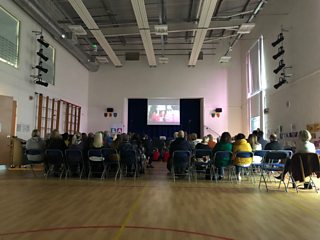
- RED CARPET – Will you have a red carpet for the event? Think carefully where guests and the film stars will be walking.
- PHOTOS – Will you have local press to cover the event? Will guests be permitted to take photographs? Have you a poster, scene from the film or characters that guests can have their picture taken with? Do they have permission to share their photographs?
- VOTE OF THANKS – During the closing speech be sure to thank anyone who has helped during the making of the film (Remember your teacher/ headteacher/ office staff/parents/any donations, etc)
- ENJOY – This is a celebration of how amazing your film is …so be sure to enjoy it.FEEDBACK & SHARING – Can you collect any feedback and comments about your film? How will you share with others? Will there be a permanent record of the film?
Vox pops
Involve as many of the pupils as possible on screen, create “Vox Pops” between the drama scenes. `
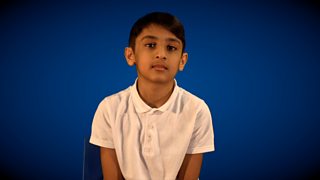
• Reinforce the key message
• Drive the story forward
• Involve more children not in key roles in the film ( good for involving those who don’t want to act)
In a Vox Pop you as ask everyone the same question and get a range of different answers.
In our drama we used 3 of these which were ‘set up’. This allowed us to give both information about a subject, which was touched on in the drama …but by planting a couple of responses we could give more background information on our character. By using this structure, it meant that we didn’t have to film lots of extra scenes explaining or showing why our character is such a bad boy. We let other children do that quickly.
Background A -The school were expecting a new headteacher – Mrs Noodal. They were getting ready for her arriving and an assembly was planned.
Background B - An Alien (unseen by children) crash landed at the school because it had run out of happiness/ calmness, an emotion which fuels the plane. Its mission is to discover lonely humans and find friends for them. When the Alien arrives at the school, it assumes the appearance of the new head teacher.
VOX POP 1 – How do the children feel about the new head teacher coming to the school?
VOX POP 2 – What’s happening at the mindfulness assembly?
VOX POP 3 – What has the naughty character has done to people ?
Links and Resources:
���˿��� Scotland LAB film resources
Here is a range of film from ���˿��� Scotland’s LAB to help you with your film making.
Have a look at The LAB Production Guides
Watch the helpful How To films by The LAB
Health and wellbeing in schools
Mental health in schools
The 2018-19 Programme for Government includes a commitment to invest in school counselling services across education in Scotland. This will create around 350 counsellor positions, ensuring that every secondary school has access to counselling services, and availability to local primary and special schools.
School counselling will enhance the work that schools already do to support children and young people to learn about mental wellbeing as part of health and wellbeing in Curriculum for Excellence. Teachers are currently supported through a range of materials provided by Education Scotland and through Scottish Mental Health First Aid training programme which is in the process of being delivered across Scotland.
Around since 1923, SAMH currently operates over 60 services in communities across Scotland providing mental health social care support, homelessness, addictions and employment services, among others.
These services together with our national programme work in See Me, respectme, suicide prevention, sport and physical activity; inform our policy and campaign work to influence positive social change.
Our knowledge, informed by rigorous research and practical based study, has been pioneering change for more than 60 years and we aren't afraid to challenge the status quo or tackle difficult or under researched issues.
'What's on Your Mind?'
The pack is to support both teachers and young people to learn about mental health and develop the skills and confidence to tackle stigma and discrimination in school and the wider community.
5-Minute Film Festival: Resources for Filmmaking in the Classroom
Explore classroom filmmaking with this video playlist of resources for teachers and students.
